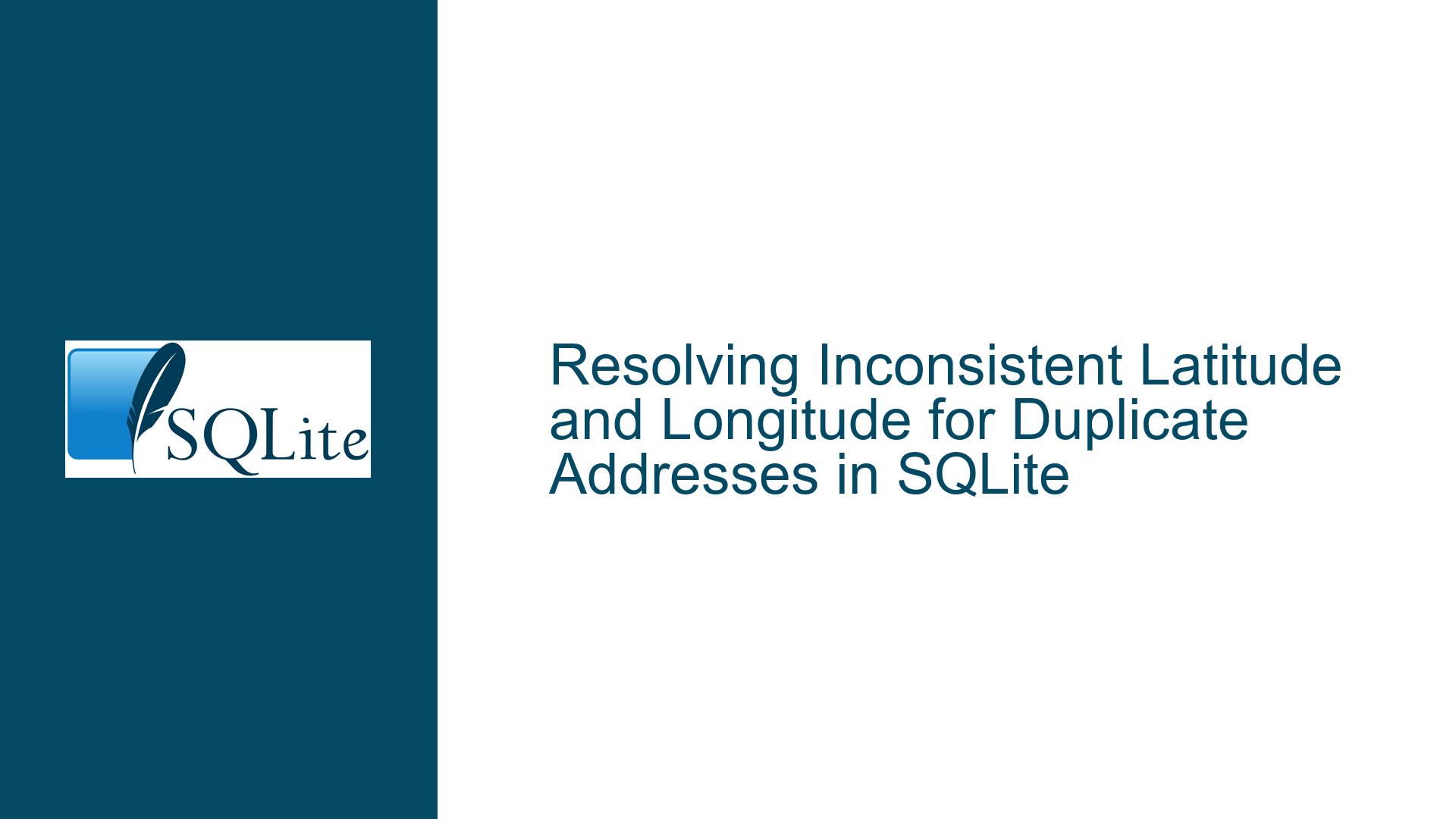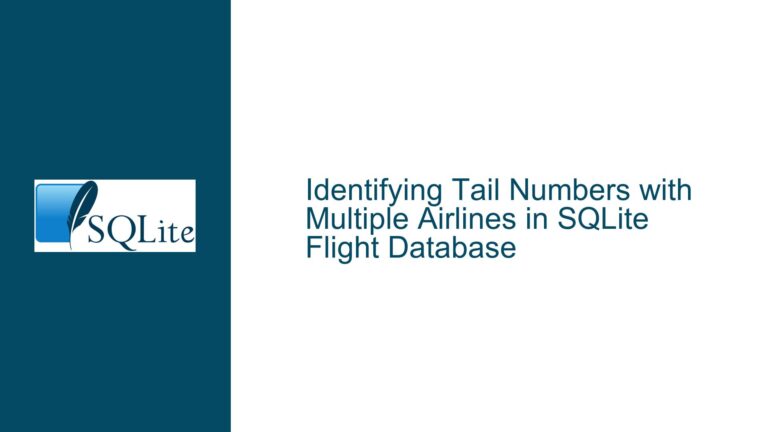Resolving Inconsistent Latitude and Longitude for Duplicate Addresses in SQLite
Issue Overview: Inconsistent Geocoordinates for Identical Addresses
In database management, particularly when dealing with geospatial data, maintaining consistency across records is crucial. The core issue here revolves around a table named ADDRESSES_ALL, which stores address information alongside latitude and longitude coordinates. The table schema is as follows:
CREATE TABLE ADDRESSES_ALL (
ID INTEGER PRIMARY KEY,
HOUSE TEXT,
STREET TEXT,
POSTCODE TEXT,
LATITUDE REAL,
LONGITUDE REAL
);
The problem arises when multiple rows in the ADDRESSES_ALL table share identical address components (HOUSE, STREET, and POSTCODE) but have differing latitude and longitude values. This inconsistency can lead to significant issues in applications relying on accurate geospatial data, such as mapping services, delivery route optimization, or location-based analytics.
The primary challenge is to ensure that all rows with the same address have identical latitude and longitude values. While this might seem straightforward, the complexity lies in determining which set of coordinates to retain when discrepancies exist. The initial assumption that minor variations in coordinates could be ignored proved incorrect, as some discrepancies were substantial enough to warrant manual intervention.
Possible Causes: Why Geocoordinates Differ for Identical Addresses
Several factors can contribute to inconsistent latitude and longitude values for identical addresses in the ADDRESSES_ALL table:
Data Entry Errors: Human error during data entry can result in incorrect or inconsistent geocoordinates. For instance, a typo in the latitude or longitude values can lead to significant deviations from the actual location.
Different Geocoding Services: Geocoding services, which convert addresses into geographic coordinates, may produce varying results based on their underlying algorithms and data sources. If the
ADDRESSES_ALLtable was populated using multiple geocoding services, discrepancies in coordinates are likely.Updates and Corrections: Over time, addresses may be updated or corrected, but the corresponding latitude and longitude values might not be consistently updated across all relevant rows. This can happen if updates are applied selectively or if the geocoding process is not rerun for all affected records.
Precision and Rounding: Geocoordinates are often stored with high precision, but slight variations in precision or rounding can lead to differences in the stored values. While these differences might be minor, they can still cause inconsistencies.
Data Merging: If the
ADDRESSES_ALLtable was created by merging data from multiple sources, inconsistencies in geocoordinates can arise if the sources used different standards or methods for determining latitude and longitude.Geocoding Service Limitations: Some geocoding services might not have comprehensive or up-to-date data for certain regions, leading to less accurate or inconsistent coordinates.
Understanding these causes is essential for devising an effective solution to the problem. Each cause may require a different approach to ensure consistency in the geocoordinates for identical addresses.
Troubleshooting Steps, Solutions & Fixes: Ensuring Consistent Geocoordinates
To resolve the issue of inconsistent latitude and longitude values for identical addresses in the ADDRESSES_ALL table, a systematic approach is necessary. The following steps outline a comprehensive solution:
Identify Duplicate Addresses with Inconsistent Coordinates:
The first step is to identify all rows in theADDRESSES_ALLtable that share the same address components (HOUSE,STREET, andPOSTCODE) but have differing latitude and longitude values. This can be achieved using a SQL query that joins the table with itself on the address components and filters for rows with differing coordinates:SELECT a1.*, a2.* FROM ADDRESSES_ALL a1 JOIN ADDRESSES_ALL a2 ON a1.HOUSE = a2.HOUSE AND a1.STREET = a2.STREET AND a1.POSTCODE = a2.POSTCODE WHERE (a1.LATITUDE <> a2.LATITUDE OR a1.LONGITUDE <> a2.LONGITUDE);This query will return pairs of rows with identical addresses but different coordinates, allowing you to assess the extent of the inconsistency.
Determine the Correct Coordinates:
Once duplicate addresses with inconsistent coordinates are identified, the next step is to determine which set of coordinates to retain. This decision can be based on several criteria:- Accuracy: If one set of coordinates is known to be more accurate (e.g., obtained from a reliable geocoding service), it should be retained.
- Recency: If one set of coordinates is more recent, it might be more reliable, especially if the address has been updated.
- Consensus: If multiple rows share the same coordinates, those coordinates might be more trustworthy.
- Manual Verification: In cases where automated methods are insufficient, manual verification might be necessary to determine the correct coordinates.
Update Inconsistent Coordinates:
After determining the correct coordinates for each set of duplicate addresses, the next step is to update theADDRESSES_ALLtable to ensure consistency. This can be done using anUPDATEstatement that sets the latitude and longitude values for all rows with the same address to the correct coordinates. For example:UPDATE ADDRESSES_ALL SET LATITUDE = :correct_latitude, LONGITUDE = :correct_longitude WHERE HOUSE = :house AND STREET = :street AND POSTCODE = :postcode;Here,
:correct_latitude,:correct_longitude,:house,:street, and:postcodeare placeholders for the correct coordinates and address components. This query should be executed for each set of duplicate addresses.Automate the Process with a Script:
If the number of duplicate addresses is large, manually updating each set of coordinates can be time-consuming and error-prone. In such cases, automating the process with a script can be beneficial. The script can:- Identify duplicate addresses with inconsistent coordinates.
- Determine the correct coordinates based on predefined criteria.
- Update the
ADDRESSES_ALLtable with the correct coordinates.
The script can be written in a programming language that supports SQLite, such as Python, and can use the
sqlite3module to interact with the database.Implement Data Validation and Constraints:
To prevent future inconsistencies, it is essential to implement data validation and constraints in theADDRESSES_ALLtable. This can include:- Unique Constraints: Enforcing a unique constraint on the combination of
HOUSE,STREET, andPOSTCODEcan prevent the insertion of duplicate addresses with different coordinates. - Triggers: Implementing triggers that automatically update the latitude and longitude values for all rows with the same address whenever a new row is inserted or an existing row is updated.
- Data Validation: Validating the accuracy of latitude and longitude values before they are inserted or updated in the table.
- Unique Constraints: Enforcing a unique constraint on the combination of
Regularly Audit and Clean the Data:
Even with data validation and constraints in place, regular audits and data cleaning are necessary to maintain the integrity of theADDRESSES_ALLtable. This can involve:- Periodically running queries to identify and resolve any inconsistencies in the geocoordinates.
- Using geocoding services to verify and update the coordinates for existing addresses.
- Removing or merging duplicate rows to ensure that each address is represented only once in the table.
Consider Using a Geocoding Service:
If theADDRESSES_ALLtable is frequently updated with new addresses, integrating a geocoding service into the data entry process can help ensure that accurate and consistent coordinates are obtained for each address. This can be done by:- Automatically geocoding new addresses as they are entered into the database.
- Periodically re-geocoding existing addresses to account for updates or changes in the geocoding service’s data.
By following these steps, you can effectively resolve the issue of inconsistent latitude and longitude values for identical addresses in the ADDRESSES_ALL table. This will ensure that your geospatial data is accurate, consistent, and reliable, which is essential for any application that relies on location-based information.






